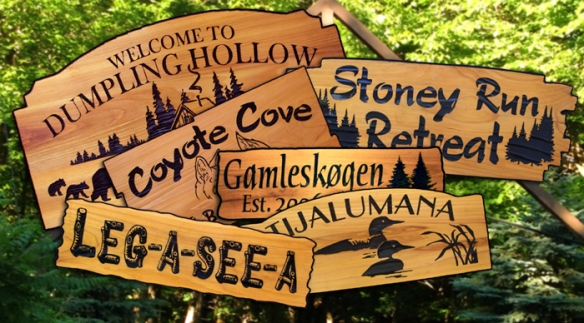“What’s in a name? That which we call a rose by any other name would smell as sweet.”
-Wm Shakespeare, spoken by Juliet in Romeo and Juliet
When purchasing a custom carved wood sign for your cabin, cottage or property, choosing the name is the first step. Many owners have already done this, but if you have not, this little article from Beaver Cut Products will help you find the inspiration to begin that process.
Place names and early terrestrial orienteering.
In a simpler time, before urban grids, sprawling cul-de-sacs, and 3-dimensional dwelling addresses, the wild lands were traversed using the paths of least resistance. Often these were trails established by migrating animals. These well-travelled paths were given names that referred to the destination point or to notable features of the landscape. Over centuries of use, the paths became roads, and settlements were started in convenient locations along the way. Houses, inns, stores and landmarks served as waypoints to help define distances and the lay-of-the-land. The names of these places would have given travelers knowledge of what to expect on their journey.
The naming of house and lands is an ancient practice, and for historians, has often provided an inroad to understanding the unwritten history of a region. Families, clans and tribes gave a human identity to the land in richly descriptive language. Eventually villages developed, and tribal customs evolved into governments. In countries where land mass was limited, the establishment and management of properties became important to those with the power of political control and inheritance. The names given to properties and dwellings are clues to the evolution of the place, and to the lineage of the inhabitants.
Place names in our present day and age.
Population density has dramatically increased the complexity of naming conventions. Urban street grids, housing development plats and apartment numbers are necessary to keep us connected, but are sterile and anonymous. Large developments are often given names that have little or nothing to do with the history of the place, and add a confusing visual noise to the cultural landscape.
Fortunately, standing out among them are the historic places and dwellings with unique and descriptive names that still serve us well and retain real meaning.
In countries where property is freely bought and sold, naming a wilderness cabin, home or property is a matter of personal choice, and not necessarily of public record. It is often done in a lighthearted manner. However, naming your cabin, house or property should be given careful thought. If it is handed down to future generations, the name may be carried on in reverence, and so can truly help create the “soul” of the place.
Today as in the past, place names will usually convey the attributes of a region. They are often an owner’s surname, or may reflect an occupation or interest. Popular names are taken from the trees, plants or animals common to the area, or from land features such as rivers, streams, valleys or mountains. Places also may refer to an event that takes place there, such as a river crossing, a display of northern lights, or a notable sunrise.
A well-chosen cabin, cottage or property name will reflect your interest in the region, and will give your place a life of its own. If it endures, it may even contribute to local history.
Choosing your name should be enjoyable, and there are many examples on our website and Facebook pages to show what others have done. Visit us at:
http://www.beavercutproducts.com
or visit Beaver Cut Products’ Facebook Page Here
– James Garrison, Minneapolis

